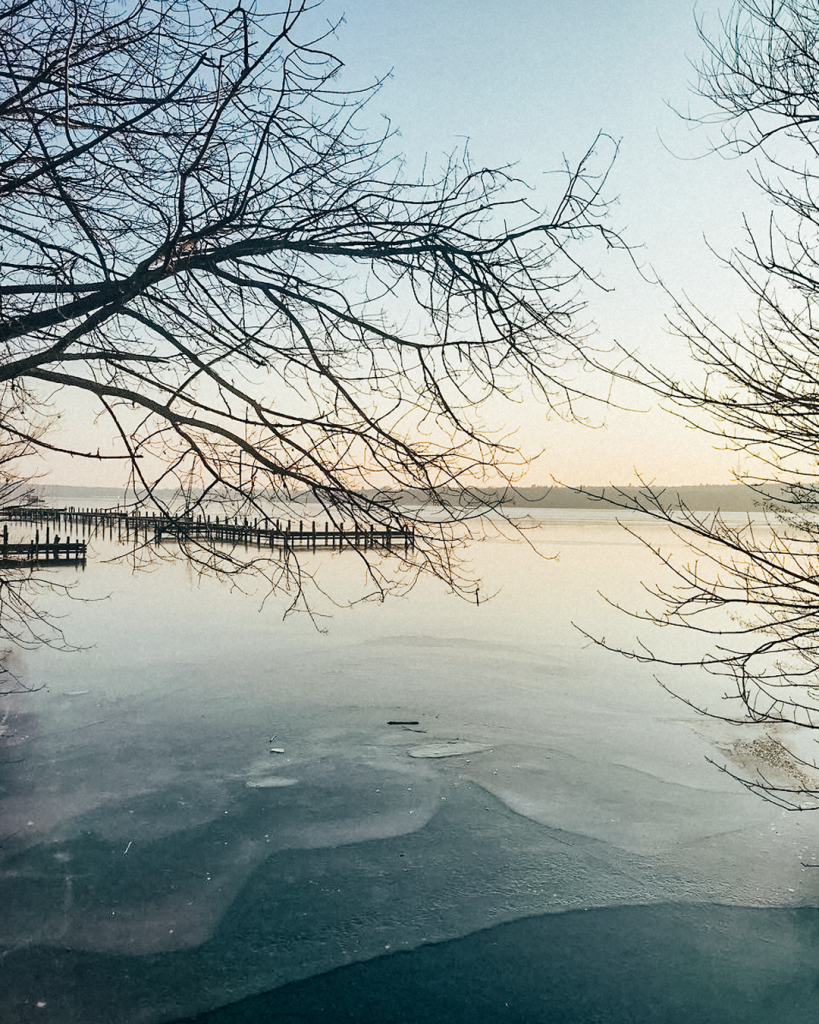Icy Lakesong & Winter Stagnation
Did you know that lakes can sing? From Germany to Norway, Canada to Antarctica, people around the globe are in awe of this phenomenon. It is known to occur naturally on frozen lakes where the water underneath the ice is moving. You can also trigger it intentionally by throwing objects, such as rocks, onto a lake’s icy surface.
An eerie mix of crackling and echo-like bubbling sounds ensue.
But to be able to understand why this happens, one must first grasp how water behaves in winter.
Dropping temperatures in autumn lead to the re-circulation of the layers of water that formed during summer. This continues until all the water in the lake reaches 4°C. Hence, by the time winter rolls around, the water in our lakes is not only back to one temperature, but also to a uniform density throughout. As we move deeper into winter, outdoor temperatures sink even further causing the top layers of water on some lakes to freeze over. When this happens, the surface temperature of the lake is thus colder than the water at its deepest point, which remains stable at around 4°C. Since frozen water has a lower density than liquid water, ice floats. Additionally, when ice forms and covers a lake’s surface, it shields the water in the lake from winds, which causes stagnation. Thus, new oxygen does not enter the lake until the ice melts. This is called ‘winter stagnation’.
Now that the water is frozen and our lakes have entered in their state of hibernation, we can focus our attention back to the eerie melodies they so mesmerizingly produce. The scientific explanation for this is simple: water contracts and expands in different temperatures. This is called ‘thermal stress’. While the air above the ice has one temperature, the ice itself has another, as does the water underneath it. These layers have different densities, causing sound to travel through them at different speeds. If an object, such as the aforementioned rock, hits the surface this results in what is known as acoustic dispersion—the sound frequencies are picked up by your ear at different times. The high notes reach your ears before the low notes, because the higher frequency vibrations move faster than those with lower frequencies. The same phenomenon occurs if winds or a current trigger the water underneath the ice to move.
Don’t believe us? Listen for yourself.

Life Underwater: Fish, Amphibians, Phytoplanktons and Plants
Lakes are brimming with life. Unsurprisingly, these life forms adapt to the changes in the waters that they call home throughout the year. As temperatures in lakes begin to move towards the 4°C mark, life underwater slows down significantly.
Fish are cold-blooded animals. Hence, their body temperatures mirror the temperatures of their environment. When this happens, they become less active because their metabolisms slow down. As a result, they require less oxygen and food for survival.
During winter, freshwater fish are known to huddle together in groups at the bottom of lakes, where the water is warmer than towards the icy surface.
It is here that they take on their restful state and limit their movements until the water begins to warm up again. Likewise, amphibians, such as frogs, seek protection at the bottom of lakes for this period of hibernation, often burrowing into sediments.
Phytoplanktons are single-celled, photosynthetic microorganisms. In warmer seasons, they float towards the top of lakes’ surfaces to reach the sunlight. In winter, on the other hand, studies have revealed that many of these phytoplanktons also settle towards the bottom of lakes, and their numbers during this period are often reduced.
Similar to plants on land during the winter months, many aquatic plants in lakes die back. Annual plants will generally disperse their seeds at the bottom of the lake, which sprout when the warmer winds comes a-knockin’ and conditions are favourable again. Perennial aquatic plants with roots, on the other hand, generally have two mechanisms for survival. Either they send up dormant shoots in the sediment, which then grow in spring. Or they die back completely, store energy in their roots, which they then use in the spring to send up new growth.
Aquatic perennials that don’t have roots have other mechanisms for survival, such as sinking to the bottom when temperatures reach a certain low, and then bobbing back up to the surface when it’s warm again.
Evergreens brave the winter by photosynthesising at a significantly slower rate than in summer. Long exposures to cold waters often damage large parts of these plants, so when spring rolls around, they then sprout new growth.
The effects that climate change will have in the upcoming years on life in lakes is still astoundingly under-researched and widely remains a matter of debate in the scientific community. It is, however, safe to say that changing outdoor temperatures are likely to affect the lifecycles and survival mechanisms of our lakes’ inhabitants. For now, we will just have to wait to see what this winter has in store for our favourite bodies of water.
For further reading:





